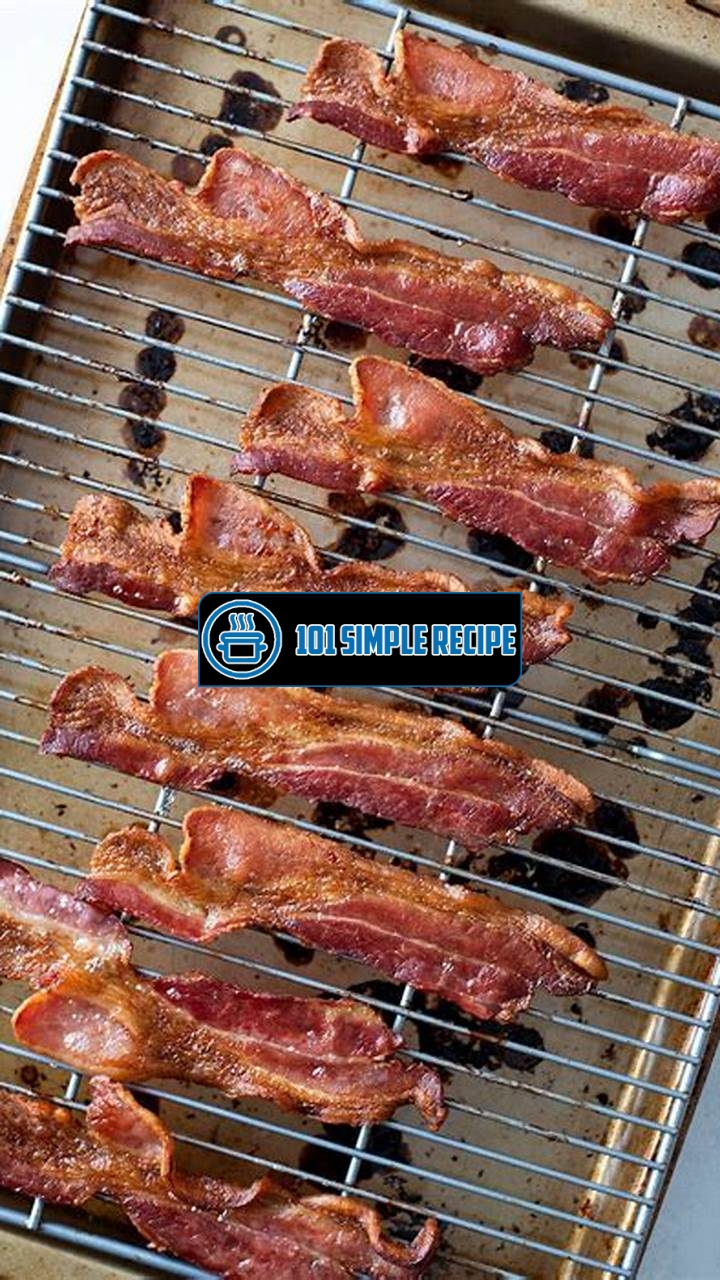Looking to master the art of creating crispy bacon? Look no further! In this article, you will discover the ultimate secrets to achieving perfectly crispy bacon every time. Whether you prefer your bacon sizzlingly crunchy or with a slight chew, these expert tips and techniques will elevate your bacon-cooking game to new heights. So grab your apron and let’s dive right in!

Understanding the Science of Bacon
Bacon is more than just a delicious breakfast staple. It is a culinary art form that requires a deep understanding of the science behind it in order to achieve that perfect crispy texture. In this section, we will explore the chemistry behind bacon and how it magically transforms into a crispy delight.
The Magical Maillard Reaction
One of the key processes that contribute to the crispiness of bacon is the Maillard reaction. This reaction occurs when amino acids and reducing sugars in the bacon react to produce a complex series of chemical compounds. These compounds give bacon its desirable brown color, rich flavor, and crispy texture.
The Maillard reaction requires specific conditions to occur. Heat is a critical factor in initiating this reaction. Bacon should be cooked at a moderate to high temperature to activate the Maillard reaction and achieve the desired crispness. ️ Additionally, the reaction requires a dry environment, as moisture can hinder the development of the crispy crust.
During the Maillard reaction, a range of aromatic compounds are formed, including pyrazines, furans, and thiazoles. These compounds contribute to the distinctive smell and flavor of bacon. They are responsible for that irresistible sizzling sound and the mouthwatering aroma that fills the kitchen when bacon hits the pan.
Fat Content and its Effect on Crispiness
The fat content of bacon plays a major role in determining its overall crispiness. Bacon with a higher fat content tends to become crispier when cooked. The fat renders out during cooking, which creates a crispy texture in the remaining meat.
When choosing bacon for crispiness, look for slices with a good balance of lean meat and fat. This combination will provide the necessary moisture and flavor, while the fat will render out and contribute to the desired crispiness. It’s important to note that leaner bacon may not achieve the same level of crispiness as bacon with a higher fat content.
The Role of Heat in Bacon Crispiness
Heat is a critical factor in achieving the perfect crispiness in bacon. Cooking bacon at too low of a temperature can result in flabby and greasy strips, while cooking it at too high of a temperature can cause it to become too crispy or even burnt.
The ideal cooking temperature for bacon is around 400°F (204°C). This temperature allows the bacon to cook evenly and renders out the excess fat while achieving that sought-after crispy texture. It’s important to monitor the cooking process closely to ensure the bacon doesn’t become overcooked.
Using a skillet or a baking sheet in the oven are both effective methods for cooking bacon. Regardless of the cooking method, it’s essential to preheat the pan or oven to allow the bacon to cook evenly and become crispy. ♨️
In conclusion, mastering the art of creating crispy bacon requires an understanding of the science behind it. The Maillard reaction, fat content, and heat all play critical roles in achieving that perfect crunch. So next time you’re cooking bacon, remember the chemistry at play and savor the crispy delight that awaits you. Enjoy!
Selecting the Perfect Cut of Bacon
When it comes to creating crispy and delicious bacon, the first step is selecting the perfect cut. With a variety of bacon options available, it’s important to explore the different types and choose the ideal one for achieving that crispy perfection you crave.
Traditional vs Thick-cut Bacon
In the world of bacon, there are two main contenders: traditional bacon and thick-cut bacon. Traditional bacon is thinly sliced and has been a favorite choice for many years. It cooks quickly and evenly, making it a popular option for breakfast meals. On the other hand, thick-cut bacon offers a meatier and more substantial bite. The thickness allows for a juicier and more flavorful experience. Additionally, the extra fat in thick-cut bacon gives it a crispier texture when cooked to perfection.
Important point: If you prefer a crispy and substantial bite, go for thick-cut bacon.
Choosing the Right Fat-to-Lean Ratio
Another factor to consider when choosing the perfect cut of bacon is the fat-to-lean ratio. Different cuts of bacon have varying ratios that can greatly affect the taste and texture of the final product. Traditional bacon tends to have a higher fat content, which results in a richer and more savory flavor. The excess fat also contributes to a crispy texture when cooked correctly.
Important point: For a flavorful and crispy bacon experience, opt for cuts with a higher fat content.
The Great Debate: Streaky vs Back Bacon
The great debate between streaky bacon and back bacon has divided bacon enthusiasts for years. Streaky bacon, also known as American bacon, is the most common type found in supermarkets. It is known for its alternating layers of fat and meat, which create a deliciously crispy and indulgent texture when cooked.
On the other hand, back bacon, commonly found in British cuisine, offers a leaner and meatier option. It is cut from the loin of the pig and has a leaner fat-to-meat ratio. Back bacon is often favored by those looking for a less fatty but equally delicious bacon experience.
Important point: Whether you prefer the crispy layers of streaky bacon or the leaner and meatier back bacon, both options can be cooked to a delicious crispiness, satisfying even the most discerning bacon connoisseur.
By selecting the perfect cut of bacon and understanding the nuances between traditional and thick-cut bacon, as well as the differences between streaky and back bacon, you can truly master the art of creating crispy bacon. Experiment with these different options to find your favorite and enjoy the crispy, savory delights of perfectly cooked bacon.
Preparing Your Bacon for Baking
When it comes to creating the perfect crispy bacon, preparation is key. By following these essential steps, you can ensure a mouthwatering result that will have everyone begging for more.
Paper Towel Pat-Down: To Rinse or Not to Rinse?
Before you begin baking your bacon, you may wonder if it’s necessary to rinse it or not. While some people believe rinsing can remove excess salt or improve the texture, it’s generally not recommended. Rinsing bacon can wash away some of the natural flavor and moisture, which can result in drier and less flavorful bacon. Instead of rinsing, try using a paper towel to pat it down. This will remove any excess moisture without sacrificing flavor.
Seasoning and Flavor Enhancements ️
Adding a little extra flavor and seasoning to your bacon can take it to a whole new level. Consider incorporating some of these delicious options:
- Black pepper: Sprinkle freshly ground black pepper over the bacon before baking for a subtle kick.
- Maple syrup: Brushing some maple syrup onto the bacon can add a touch of sweetness and caramelization.
- Paprika: For a smoky flavor, dust the bacon with a sprinkle of paprika.
- Garlic powder: Add a hint of savory goodness by lightly dusting the bacon with garlic powder.
Experiment with different combinations of seasonings to find your perfect flavor profile. Remember, a little goes a long way, so don’t overpower the natural taste of the bacon. ️
To Marinate or Not to Marinate? ️❓
Marinating bacon might not be something you’ve considered before, but it can be a game-changer when it comes to flavor infusion. While bacon is already bursting with taste, marinating it can add an extra layer of deliciousness. Here are a few marinade ideas to try:
- Soy sauce and honey: Create a sweet and savory glaze by mixing soy sauce and honey. Brush the mixture onto the bacon before baking for a delightful combination of flavors.
- Brown sugar and mustard: For a tangy and slightly sweet twist, combine brown sugar and mustard. Spread it over the bacon and let it marinate briefly before baking.
- Bourbon and brown sugar: Infuse a rich and smoky flavor into your bacon by combining bourbon and brown sugar. Let the bacon soak in the marinade for a while to allow the flavors to penetrate.
Remember, marinating bacon adds moisture, so you may need to adjust the cooking time slightly to achieve the desired crispiness. Give it a try and elevate your bacon to a whole new level of deliciousness.
Mastering the Baking Process
When it comes to creating that perfect, crispy bacon, there’s no better method than baking it in the oven. This step-by-step process will guide you towards achieving the ultimate crispiness that will have your taste buds begging for more.
Choosing the Right Oven Temperature
The first key to mastering the baking process is selecting the right oven temperature. Preheating your oven to 400°F (205°C) will provide the ideal environment for your bacon to crisp up perfectly. This temperature allows for a balance between cooking the bacon through while achieving that desired crispy texture.
Pro Tip: If you prefer your bacon a bit chewier, you can lower the temperature slightly to 375°F (190°C). However, keep in mind that this may result in less crispy bacon.
Optimal Baking Time for Different Cuts
Now that you have set the right oven temperature, it’s time to consider the optimal baking time for different cuts of bacon. The average thickness of bacon slices will dictate the baking time required for that delectable crunch.
Regular Cut Bacon: For regular cut bacon slices, you can expect a baking time of around 12-15 minutes. Keep a close eye on it towards the end to ensure it doesn’t become overcooked or burnt.
Thick Cut Bacon: If you prefer the hearty thickness of bacon, it will require a slightly longer baking time. Aim for 18-22 minutes to allow the bacon to reach that perfect balance of crispiness and tenderness.
Special Techniques for Achieving Extra-Crispy Bacon
If you’re looking to take your bacon to the next level of crispiness, there are a few special techniques you can employ during the baking process.
✨ Rack it Up: Placing the bacon on a wire rack instead of directly on the baking sheet allows the hot air to circulate evenly around the bacon, resulting in maximum crispiness.
✨ Sweet and Savory: Adding a light dusting of brown sugar or brushing the bacon with maple syrup before baking can enhance the flavor and help create an extra crispy caramelized coating.
✨ Broil to Perfection: For a final touch of crispiness, switch your oven to broil for the last couple of minutes. This quick burst of high heat will give your bacon that delightful crunch that will leave everyone wanting more.
Remember, achieving the perfect crispiness when baking bacon is all about finding the right balance between oven temperature, baking time, and special techniques. With practice and a dash of creativity, you’ll master the art of creating crispy bacon that will delight your taste buds every time!
Troubleshooting and Tips for Perfect Bacon
Troubleshooting and tips for achieving consistently crispy bacon are essential for any bacon lover. There is nothing quite like the delicious crunch of perfectly cooked bacon. However, it’s not always easy to achieve that ideal texture. In this article, we will explore common issues that can arise when cooking bacon and provide expert tips to help you master the art of creating crispy bacon.
Dealing with Bacon Shrinking
Bacon shrinking is a common issue that can result in uneven cooking and less desirable texture. When bacon shrinks in the pan, it can cause it to become curly or wavy, making it harder to cook evenly. To prevent bacon from shrinking, try the following tips:
- Cold Start: Start cooking bacon in a cold pan instead of preheating it. This allows the bacon to gradually heat up, reducing the chances of it shrinking.
- Thicker Cuts: Opt for thicker cuts of bacon, as they are less likely to shrink compared to thin slices.
- Cooking Time: Cook bacon over medium heat instead of high heat. This slower cooking process can help minimize shrinkage.
- Pat Dry: Before cooking, pat the bacon slices dry with paper towels. This removes excess moisture that can contribute to shrinkage.
By following these tips, you can minimize bacon shrinkage and ensure a more consistent cook.
Preventing Bacon from Sticking to the Pan
Having bacon stick to the pan can be frustrating and can lead to uneven cooking and messy cleanup. To prevent bacon from sticking, consider these helpful strategies:
- Non-Stick Pan or Griddle: Cook bacon in a non-stick pan or on a non-stick griddle to minimize the chances of it sticking.
- Preheating the Pan: Ensure that your pan or griddle is properly preheated before adding the bacon. This creates a hot surface that helps to prevent sticking.
- Oil or Butter: Apply a thin layer of oil or butter to the pan before adding the bacon. This can provide an additional barrier against sticking.
- Flip with Care: When flipping the bacon, use a spatula to gently lift and turn the slices. Avoid forcefully scraping the bacon off the pan, as this can cause it to stick.
By implementing these preventive measures, you can enjoy perfectly cooked bacon without the hassle of it sticking to the pan.
Reducing Splatter and Grease
Splattering grease can create a mess in the kitchen and even pose a safety risk. To minimize splatter and grease when cooking bacon, try these tips:
- Use a Splatter Screen: Place a splatter screen over the pan while cooking bacon. This allows steam to escape while trapping hot grease and minimizing splatter.
- Baking Method: Consider baking bacon in the oven instead of frying it on the stovetop. This method reduces splatter and allows the bacon to cook more evenly.
- Draining: After cooking, transfer the cooked bacon to a paper towel-lined plate or wire rack to allow excess grease to drain away.
- Alternative Cooking Surfaces: If splatter is a major concern, try grilling or microwaving bacon. These methods often result in less splatter compared to stovetop frying.
By employing these techniques, you can enjoy crispy bacon while minimizing the mess and grease associated with cooking it.
In conclusion, troubleshooting and tips for creating crispy bacon are valuable knowledge for any bacon enthusiast. By addressing common issues such as bacon shrinking, sticking, and splatter, you can achieve consistently delicious results. Experiment with these tips, and soon you’ll be serving up perfect, crispy bacon every time.
Crispy bacon can be a perfect pairing with a delicious brownie cookie
Frequently Asked Questions
Here are some common questions you might have about baking crispy bacon:
| No. | Questions | Answers |
|---|---|---|
| 1 | How long should I bake bacon in the oven? | For crispy bacon, bake it in a preheated oven at 400°F (200°C) for about 15-20 minutes, or until it reaches your desired level of crispiness. |
| 2 | Should I use parchment paper or a baking rack? | Using a baking rack on top of a baking sheet allows the bacon to cook more evenly, and the excess grease to drip away, resulting in crispier bacon. |
| 3 | Can I use thick-sliced bacon? | Yes, you can use thick-sliced bacon. Just note that it may require a longer cooking time to achieve crispiness. |
| 4 | Should I flip the bacon while baking? | There is no need to flip the bacon while baking. However, if you prefer a more even crispness, you can turn the bacon over halfway through the cooking time. |
| 5 | How do I store leftover crispy bacon? | Allow the leftover bacon to cool completely, then store it in an airtight container in the refrigerator for up to 3 days. To reheat, you can use a microwave or oven. |
| 6 | Can I freeze cooked bacon? | Absolutely! Cooked bacon freezes well. Just place the cooled bacon in a freezer bag or container, and it can be stored in the freezer for up to 3 months. |
Thanks for Reading, and Happy Baking!
We hope this guide on how to bake crispy bacon has been helpful to you. Now that you know the secrets to achieving perfectly crispy bacon, it’s time to put your new skills to the test. Whether you’re cooking up a delicious breakfast or adding crispy bacon to your favorite recipes, we’re confident you’ll enjoy the results. If you have any more questions or need further assistance, feel free to visit our website again later for more cooking tips and recipes. Enjoy your crispy bacon adventures!
Jump to Recipe
How to Bake Crispy Bacon

Learn how to bake crispy bacon in the oven with this easy and foolproof method. Perfectly crispy bacon every time!
- 8 slices of bacon
- Optional: black pepper (brown sugar, or other desired seasonings)
- Preheat your oven to 400°F (200°C).
- Line a baking sheet with parchment paper or place a baking rack on top of a baking sheet.
- Place the bacon slices in a single layer on the baking sheet or rack. If desired, sprinkle with black pepper, brown sugar, or your preferred seasonings.
- Bake in the preheated oven for 15-20 minutes, or until the bacon reaches your desired level of crispiness.
- Carefully remove the baking sheet or rack from the oven and transfer the bacon to a paper towel-lined plate to drain off any excess grease.
- Serve the crispy bacon hot and enjoy as a standalone snack or add it to your favorite recipes for an extra burst of flavor and crunch.






